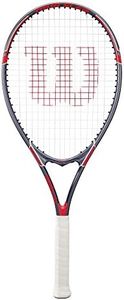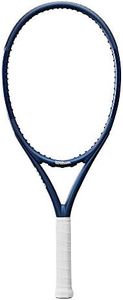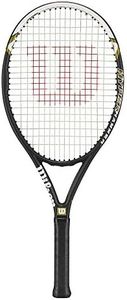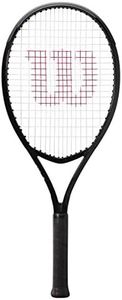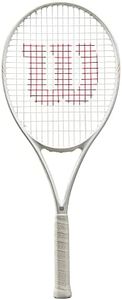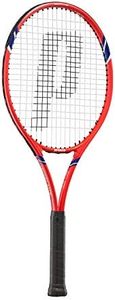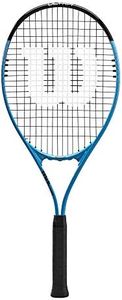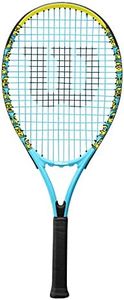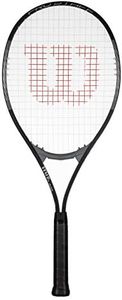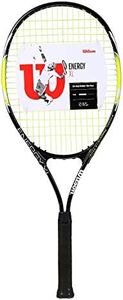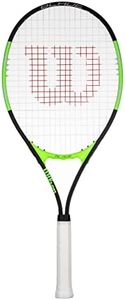We Use CookiesWe use cookies to enhance the security, performance,
functionality and for analytical and promotional activities. By continuing to browse this site you
are agreeing to our privacy policy
10 Best Oversize Tennis Racquet
From leading brands and best sellers available on the web.Buying Guide for the Best Oversize Tennis Racquet
Choosing the right oversize tennis racquet can make a big difference in your game, especially if you're looking for more power and a larger sweet spot. The term 'oversize' refers to racquets with a larger head, providing more forgiveness on off-center hits and often making it easier to play for beginners or players who prioritize comfort and less stress on the arm. To find a racquet that’s the best fit for you, you should consider a few key specifications that influence how the racquet feels and performs on the court.Head SizeHead size is the measurement of the racquet's hitting surface, usually given in square inches or centimeters. In oversize racquets, this typically ranges from about 105 to 135 square inches. A larger head size means a bigger sweet spot, which makes it easier to hit powerful shots, even if you don’t make contact right in the center. For most beginners or recreational players, a larger head (115+ sq in) offers maximum forgiveness. Intermediate players might choose something slightly smaller (105-115 sq in) for better control, while still enjoying a bigger sweet spot than standard racquets. You'll want to choose the size that balances your ability to hit clean shots with your need for forgiveness and power.
WeightThe weight of a racquet is simply how much it weighs, typically measured in grams or ounces. Lighter racquets are easier to swing and are often preferred by beginners or those who want to avoid arm fatigue, but they can offer less stability against fast shots. Heavier racquets provide more stability and power, and are often used by stronger or more advanced players. In oversize racquets, lightweight options (around 255-285 grams) suit players with less strength or who value quick reactions, while heavier ones (290 grams and up) are better for players who can generate their own swing speed and want more stability. Choosing the right weight should depend on your playing strength, how much racquet you can comfortably handle, and your preference for maneuverability versus stability.
BalanceBalance refers to the distribution of weight in the racquet—whether most of the mass is in the head (head-heavy), the handle (head-light), or evenly distributed (even balance). Head-heavy oversize racquets increase power and help generate momentum with each swing, while head-light racquets offer better maneuverability and control, making it easier for quick net play. Players who hit from the baseline may prefer head-heavy models, while those who like to volley and want control at the net might benefit from head-light options. Consider how you play: aggressive baseline hitters may favor head-heavy, while all-around or net players might pick head-light for agility.
String PatternString pattern refers to how the racquet’s strings are woven together, usually described as open (fewer strings) or dense (more strings). Open string patterns (like 16x19) provide more power and spin, as the ball sinks deeper into the strings, while denser patterns (like 18x20) offer more durability and control. For players who like to hit topspin or need more help generating power, an open pattern is advantageous. If you’re harder on strings or want consistent shot placement, a denser pattern may be preferable. Your playing style and how much you value spin versus control should guide your choice here.
LengthThe standard tennis racquet length is about 27 inches, but oversize racquets can be slightly longer—up to 29 inches. A longer racquet can provide extra reach on shots and a little more power on serves, but it may be harder to maneuver, especially at the net. If you need help reaching wide balls or serve frequently, a slightly longer racquet might benefit you. However, younger players or those who like quick reactions may stick to the standard length for easier handling. Match the racquet length to your comfort with reach versus maneuverability.
Grip SizeGrip size is the circumference of the handle—the part you hold. Getting this right is important to avoid hand fatigue or injury. Too small a grip can make you over-grip and strain your hand, while too large can limit maneuverability. Grip sizes usually vary from about 4 to 4 5/8 inches. You can measure your hand or test out racquets in person to see what feels comfortable. Choose the one that feels secure and allows you to play comfortably for long periods.
